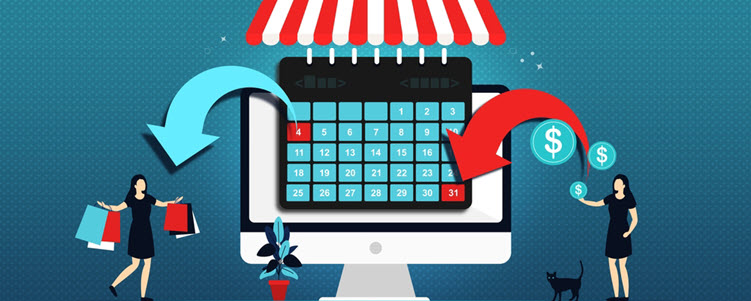As the business world gets more connected, ecommerce is becoming one of the most forward-thinking global markets.
In 2022, retail ecommerce sales will reach $5.545 trillion, with about 4 billion ecommerce users worldwide.
Various factors, such as the development of the global mobile market, new technologies like artificial intelligence (AI) and augmented reality (AR), the COVID-19 pandemic, and many other factors have influenced the way people choose, purchase, and pay for goods and services. As a result, new business trends have cropped up.
This article reveals the major ecommerce trends for 2023 to help merchants adjust to the changes and ensure a stable business presence.
15 Ecommerce Trends You Should Pay Attention to
In the dynamic ecommerce market, merchants must keep up with trends to continue generating new leads and retain their long-term customers.
Here are the 15 critical ecommerce trends merchants should pay attention to in 2023.
1. AI-Assisted Upselling and Cross-Selling

Machines are learning faster than ever before. Artificial intelligence (AI) software can process ever more data on buyers’ shopping habits and bring valuable insights to merchants
Based on the insights provided by AI, ecommerce store owners can send personalized cross-sell or upsell deals.
If a customer has just bought a guitar, to cross-sell would mean offering them strings or picks. Upselling would involve offering the buyer a more expensive guitar. AI does the job of remembering when a buyer buys an item and coming up with an attractive (and profitable) offer.
Most merchants still can’t process enough data for AI-assisted upselling and cross-selling. However, customer relationship management (CRM) and enterprise resource planning (ERP) systems are making significant progress in adding AI features to enhance the cross-selling and upselling capabilities of merchants.
2. Augmented Reality (AR) to Visualize Purchases
Augmented reality (AR) has been with us for some time. However, it’s only recently that merchants have started widely using AR to help their customers make purchases more easily.
With AR, there’s no trial and error in shopping. Customers can visualize the products they’re planning to buy using an AR app. From checking how a new piece of furniture or artwork will fit into their living room to “trying on” a piece of jewelry or clothes, AR has various uses in ecommerce.
By reducing the chance of buying the wrong product, customers save time and money and merchants offer a smooth buying experience while preventing potential refunds and chargebacks.
IKEA Place is an AR app that helps potential IKEA customers check how the furniture they want to buy will look in their homes.

3. Omnichannel Shopping
Omnichannel refers to the smooth and seamless transition between different sales channels during a single shopping experience. An example of omnichannel shopping is when a customer receives an SMS with a promotional code they can use to get a discount and buy an item online.
Starbucks is a fine example of the omnichannel approach. Their Starbucks Rewards program offers a unified shopping experience as customers can pay for a coffee in advance and pick it up in the store. At the same time, customers collect loyalty points and get freebies.

Bear in mind that an all-round omnichannel strategy requires technical capabilities, such as AR, voice search, and data collection, to ensure full integration between different ecommerce channels, customers, and the brand.
Note: Learn more about omnichannel and multichannel from our article Omnichannel Vs. Multichannel: What Are the Differences??
4. Google’s Cookie Policy Updates
As concerns over data security grow, Google wants to limit unnecessary data collection by removing third-party cookies from Chrome. These are cookies developed by third parties and used by websites for the purpose of data collection and analytics.
Google has been preparing to phase out third-party cookies in Chrome for some time. The phase out was initially planned for 2022 but the removal has been postponed to 2023.
Merchants need to prepare for this measure because it will significantly change how customer data is collected and stored. In the near future websites will be allowed only to use first-party cookies, i.e., only the cookies served by the website’s server. That way, the data collected is not shared with a third-party provider.
It’s important to realize that the world is moving toward zero-party data. This refers to users voluntarily sharing their personal data and buying habits with brands, rather than merchants monitoring their activities. Every aspiring ecommerce entrepreneur will be trying to reach that level of customer loyalty in the near future.
5. Livestream and Video Shopping
Live shopping used to be reserved for television. Sellers would showcase a certain product in a special commercial TV program and buyers would order the item via a phone call.
Today, any merchant can organize a live shopping session through online streaming media. Businesses can promote their products and services in real-time and engage with their customers more intimately.
Online live stream shopping lets brands directly promote new items fresh from the oven, without having to wait for a regular advertising cycle.
Avon has already started using live shopping to familiarize its audience with new products. They also offer special giveaways and discounts on premium products during live streams, encouraging buyers to watch these events and actively participate in them.

6. Alternative Payment Methods
As reported by JP Morgan, credit cards are still the most popular online payment method in the US. However, there has been a fast rise in the use of digital wallets and mobile payments driven by buyers in the 18-24 age group. Alternative payments are here to stay and merchants should analyze their target audience to offer their buyers’ preferred payment methods.
The credit card market share for online shopping in Europe is only 19%. Domestic card schemes, SEPA, and cash-on-delivery are more popular payment methods in European countries than traditional credit cards, like Visa or Mastercard.
Merchants aiming to cover international audiences in 2023 need to offer both mainstream and alternative payment methods to improve customers’ shopping experience and prevent cart abandonment.
Note: Refer to our article ACH vs SEPA to learn more about these two payment types.
7. Buy Now Pay Later (BNPL)

Some buyers prefer planning their purchases, saving up the money, and paying for everything on the spot. Others take shopping more flexibly and like spur-of-the-moment buying. Their preferred payment method is to buy now, pay later (BNPL), which works as a kind of loan between the merchant and the customer.
When a customer buys a product, the total sum is divided into several installments. The number of portions to be paid depends on the price, the merchant’s offer, and the customer’s preferences. Typically, the first installment is paid at checkout and the remaining installments are debited successively from the customer’s card.
BNPL payments usually don’t impose additional interest if customers pay all the installments on time.
8. Sales within Metaverse and Similar Platforms

The term metaverse refers to a network of virtual worlds that focus on online social interaction and networking.
In 2021, Facebook started using the name Meta for its digital platforms with the aim of rebranding as the metaverse. Other companies, such as Microsoft, are following suit, trying to get the edge in winning over customers in the digital world.
In the metaverse, users create customized avatars to interact with one another for gaming, business, or other purposes. Consequently, shopping in the metaverse will be one of the important trends going forward.
For instance, people can already buy different things in this cyberspace, from virtual products to digital land. For these transactions, cryptocurrencies are the primary payment option while physical products can also be sold as non-fungible tokens (NFTs).
9. Subscription-Based Ecommerce Businesses

As predicted by Statista, subscription ecommerce sales soared in 2022, surpassing $32 billion. This means the revenue of subscription-based businesses will double compared to 2019.
Customers like subscriptions because of their flexibility. There are no contractual obligations, and most subscriptions are scalable, meaning that payers can easily upscale or downscale the services they’re using.
Merchants should prepare both monthly and annual subscriptions to cover as many potential subscribers as possible. Offering discounts on one-time payments for long-term subscriptions increases customer loyalty and reduces churn rates.
10. m-Commerce Expansion

Mobile commerce (m-commerce) refers to online purchases made via smartphones and tablets.
In 2021, m-commerce sales amounted to $360 billion, with growth expected to reach $430 billion in 2022.
There are three subcategories of mobile commerce:
- Mobile shopping. Mobile shopping refers to commerce in which customers buy products via their mobile devices from applications such as eBay, Amazon, or through web-based apps. This includes in-app purchases, as well.
- Mobile banking. Mobile banking is based on special apps provided by banks to enable their users to make electronic payments from their bank accounts.
- Mobile payments. Customers using mobile payments can pay for products or services via mobile wallets, such as Google Pay, Apple Pay, or CCBill Pay. They don’t need to bring cash or payment cards to make purchases. All the payment data is stored on their mobile wallets. This is expected to be one of the most popular payment trends.
As the global mobile market grows, it is opening numerous opportunities for both merchants and mobile shoppers. M-commerce is especially convenient for remote and developing regions because it doesn’t require any particular banking infrastructure.
11. Social Commerce

Social commerce unifies social media and ecommerce into an integrated shopping experience.
The rapid global growth of the mobile market coupled with the COVID-19 pandemic has increased the number of people making purchases directly via social media. In 2021 about 7% of all online purchases were made via social media.
It’s expected that social commerce revenue surpasses $3.37 trillion by 2028, meaning that 2022 was the right time to start generating revenue through social commerce. Start with Facebook and Instagram ecommerce and consider spreading your services to TikTok and other social networks relevant to your business.
12. Enhanced Post-Purchase Experience
Ecommerce brands are testing various customer retention strategies to build long-term relationships and stay ahead of the game.
The checkout should not be the final stage of the buying cycle. Post-purchase customer service plays an important role in turning one-time buyers into repeat customers.
Develop an onboarding procedure for customers for each product or service. Create tutorials, explainer videos, how-to guides, and other similar content that shows buyers how they can benefit from your products and services.
Ask for customer feedback after the purchase and track customer purchases for upsell and cross-sell opportunities.
13. DTC (Direct to Consumer) Evolution
Even though ecommerce giants, like Amazon, are still important, more and more companies are launching their own online stores. Instead of paying service fees to third parties these businesses are investing in ecommerce platforms.
By skipping resellers, DTC companies connect directly with their customers via social media, podcasts or streaming platforms and offer lower prices, while ensuring higher profits.
The Dollar Shave Club is a well-known brand that uses the DTC business model. They sell razors and other shaving cosmetics directly to their customers. You fill out a questionnaire to let them know more about your shaving habits and preferences. After that, you become a club member and regularly receive a selection of products without any middlemen. You can stop using their services and products whenever you want by canceling the membership.

14. Faster Delivery Services
A survey conducted in 2020 showed that 65% of U.S. consumers expect their goods to be delivered in 2 to 3 days. About 30% of American retailers planned to reach that goal in 2022. A similar percentage of retailers are aiming for next-day delivery to become their standard shipping time.
This data shows that shipping has become an important factor in winning over customers. Buyers are more likely to stop purchasing a company’s products or services if they experience delayed delivery without timely notice.
Here are some ideas to enhance your customers’ delivery experience:
- Introduce a transparent delivery policy and make sure to communicate shipping details with customers.
- Allow split orders and let your customers use the pay-online-pick-up-in-store option.
- Customize the purchase experience by informing customers when certain products are back in stock.
- For higher volumes and larger orders, contact customers directly via phone or email to arrange the delivery dates.
- Highlight additional delivery costs and inform customers from certain geographical regions about those special rules.
15. Advanced Voice Search

While voice search itself is not a new concept, it is spreading to areas where it wasn’t used before.
AI-based voice assistants, like Apple’s Siri or Microsoft’s Cortana, have become standard in the last few years. Apart from that, voice search is now integrated into cable TV remote controls, home entertainment hubs, and other communication channels.
To keep up, ecommerce business owners need to optimize their ecommerce sites and apps for mobile voice search.
Customers have already embraced voice commerce. More than 45 million US buyers used voice search for shopping in 2022.
This technology simplifies and accelerates the shopping experience since voice search is more convenient and faster than typing. Hence, voice search will be one of the major game-changers in ecommerce in the time ahead.
Conclusion
In this article, we have presented trends to be considered by any ecommerce merchant looking to grow their business in 2023. Not all ideas will suit every company so before investing in costly innovations, make sure you know your ideal customer.
Keeping up with the competition is becoming increasingly complex so merchants who stay ahead of the game are more likely to retain existing customers, attract new ones, and ensure steady revenue in the times ahead.
